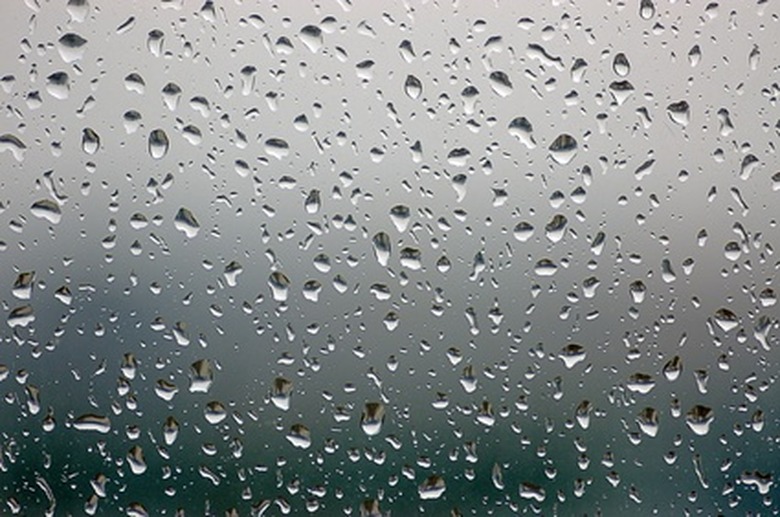Effects Of Rain Water
Rain is the liquid form of water that falls from clouds. Many organisms on Earth, including humans, depend on rain to sustain life and provide hydration. Rainfall amounts vary depending upon location, season and the movement of air masses, temperature and other abiotic factors. At times, too much rainfall proves to be a detriment.
TL;DR (Too Long; Didn't Read)
There are many effects of rain water, both positive and negative. Positive effects include the necessary water for life and plant growth. Negative rain effects include flooding and the resulting risk to life and infrastructure.
Positive Effects of Rainfall
Positive Effects of Rainfall
All life on Earth requires water. Many forms of life receive water directly or indirectly from rainfall or other forms of water precipitation. As rainfall, water is used by plants after it falls to the Earth. Plant roots absorb water, which travels up the column of the plant stem to the leaves. From there, the leaves absorb sunlight and use the process of photosynthesis to make sugar to feed the plants. All of this falls under a positive effect of rainfall.
Scientists are also learning more about how animals benefit from the positive effects of rainfall. Researchers have defined the hygic niche, which describes the range of interactions warm-blooded animals experience with their environment during precipitation. More than just a food supply issue, rainfall affects animal behavior and population growth.
The Effect of Rainfall on Soil and Plants
The Effect of Rainfall on Soil and Plants
While the impact of rainfall on plants is generally positive, there can be too much of a good thing. When there is too much water in the form of rainfall, a number of negative effects take place. Excessive rainfall can damage plants and compact the soil. When soil becomes compacted, erosion eventually occurs.
Additionally, too much rain leads to reduced soil oxygen, and this can lead to root loss that stifles a plant's growth. Excessive rainfall also results in the leaching of certain key nutrients for plant survival, such as nitrogen. If you grow your own plants, one way to aid in good drainage during heavy rain is to plant them in raised beds.
Excessive Rainfall Risks
Excessive Rainfall Risks
Humans also experience a number of risks from too much rainfall. Flooding risks human life, damages buildings, roads, and bridges and devastates livestock and crops. The effects of rainfall can even impact forests, especially when combined with high winds.
One development that has influenced the impact of rainfall is the heat island effect. Large metropolitan areas warm significantly more than non-urban areas around them, making them heat islands. This also affects precipitation patterns, because higher temperatures lead to greater cloud cover over cities. This in turn leads to higher precipitation and much more intense rainfall.
Heavy rainfall effects in urban areas can be catastrophic, endangering lives and damaging infrastructure. With several large urban centers located close together, such as on the eastern seaboard of the United States, a significant impact of atmospheric effects results from these heat archipelagos. It creates a vicious cycle, because in cities, increased pavement and parking lots give rain little chance to run off, and it cannot seep into the soil well. Urban planning professionals will need to take this into consideration, especially with the increasing impact of climate change on our weather patterns.
Reduced Rainfall Effects
Reduced Rainfall Effects
While some areas might experience more extreme rainfall events, the opposite scenario of receiving less rainfall than historically measured might affect others. One prime example of this is the effect of deforestation on the Brazilian Amazon.
As the Amazon has been lost in increasing amounts, rainfall amounts have also fallen dramatically. The Amazon forests are directly related to rain effects around the globe, particularly within the Brazilian Amazon. This in turn has led to decreased productivity for farming crops, since Amazonian agriculture chiefly receives water from rainfall.
Strategies for Dealing with Rain Effects
Strategies for Dealing with Rain Effects
With such a great variety of impacts of rainfall, there need to be strategies in place for heavy rain events. The 21st century has brought about rapid technological change, and some of the innovations are being used to help improve weather forecasting. The use of supercomputers can aid weather prediction models, preparing society for severe weather events. Supercomputers can develop high-resolution forecast models to run heavy rainfall simulations.
Studying rainfall's freshwater effects on upper-ocean salinity, which in turn affects weather systems, is another mechanism to study the effect of rainfall across the globe.
As climate change leads to a greater impact of rainfall in some areas of the world, it is more important than ever to be able to track extreme rainfall events. Additionally, understanding how animals and plants benefit from the positive effects of rainfall can help conservationists determine how better to protect and prioritize habitats.
References
- Oceanography: Effects of Rainfall on the Atmosphere and the Ocean During SPURS-2
- PennState Extension: How Too Much Rain Affects Your Garden
- National Institute of Water and Atmospheric Research: Extreme Weather – Heavy Rainfall
- EurekAlert: Importance of Rainfall Highlighted for Tropical Animals
- Nature Communications: Deforestation Reduces Rainfall and Agricultural Revenues in the Brazilian Amazon
- University of Delaware UDaily: Cities and Rainfall
Cite This Article
MLA
Hermance, Dianne. "Effects Of Rain Water" sciencing.com, https://www.sciencing.com/effects-of-rain-water-12393648/. 2 November 2021.
APA
Hermance, Dianne. (2021, November 2). Effects Of Rain Water. sciencing.com. Retrieved from https://www.sciencing.com/effects-of-rain-water-12393648/
Chicago
Hermance, Dianne. Effects Of Rain Water last modified March 24, 2022. https://www.sciencing.com/effects-of-rain-water-12393648/
